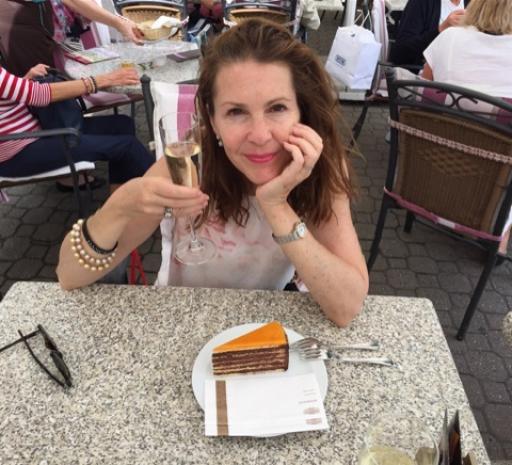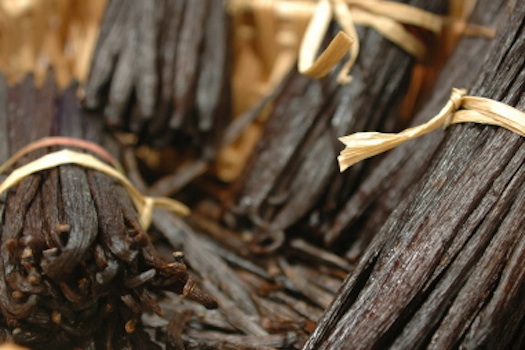
Recently Rated:
...from Zester Daily
The electric green and pink box contained a candy bar like nothing I'd ever seen: a green tea and cherry blossom Kit Kat bar from Japan. This exotic gift came courtesy of my friend Susan Heeger, who had recently returned from a trip to the island nation. I marveled at the package and its contents: How could the Kit Kat inside the box, with its cherry blossom wrapper and its playful Hello Kitty sensibility, dare to differ so wildly from its American cousin? Why did it have its own box, pre-printed with a mailing label? Uniformity is prized in the mass-marketing of candy bars, so I wondered why Kit Kat, the crunchy, milk-chocolate drenched wafers sold in a wrapper as red as the stripes on the American flag, would contain green tea and cherry blossoms in Japan. And why was it adorned with a Nestle label when it's a Hershey's product in the States?
In America, the Kit Kat brand of candy bar is licensed by Hershey's, and flavors are only modest variations of the classic -- a little peanut butter here, a little dark chocolate there. Each "finger of the traditional four finger bar can be snapped off one at a time, thus inspiring its new tag-line: Break Time, Anytime. Yet this Japanese version seemed to be a wild mutation of the classic. Made of green-tinted white chocolate with a faint hint of green tea flavor, it offered a satisfying sweetness like the American version, but with the pronounced sugary notes of white chocolate and cherry fruit anchored by the undertones of bitter green tea
My friend Susan explained that Kit Kats are tokens of good luck there. They have become popular because of the similarity between the bar's name and the Japanese phrase kitto katsu, which roughly translates to "You will surely win!" This inspires parents to send school children a Kit Kat bar as a good luck charm on a school day. Or, kitto katto can be understood to bestow Kit Kat with the less positive significance of "you will surely miss the cut. Gifts of a single Kit Kat are a running joke for senior high school students taking university entrance examinations, according to Wikipedia.
Daring flavors of Kit Kat have been released for short periods of time in Japan: maple syrup, melon, vanilla bean, grape, apple, banana, caramel, kiwifruit, azuki, green tea, yuzu and cherry blossom have all appeared on shelves. Further building on the teen market, Nestle created a music label in 2005 and bundled Kit Kats with CDs, which has propelled the Kit Kat to become the No. 1 selling candy bar there.
In the States, the candy bar has a much more conservative stance as one of the great classics of American childhood. It has changed little since its early days. Kit Kats were first developed by Rowntree in England in 1935 as Rowntree's Chocolate Crisp. The formula of chocolate-coated wafers stacked an inch tall to form a "finger, combined in a hand of four, enrobed in milk chocolate and wrapped in a bright red wrapper changed little in the course of a century and was a bestseller. Nestle bought Rowntree in 1988 and licensed the brand to Hersheys for U.S. distribution. Aside from a few stylistic changes to the label and variations such as the "chunky textured option, it is still the same crispy, crunchy confection it has been for 80 years.
Want to get your hands on one of the Japanese varieties? Many of the adventuresome flavors of Kit Kat are available online through a quick Google search. Or try this recipe for white chocolate and green tea cherry truffles, inspired by my Japanese gift.
White Chocolate and Green Tea Cherry Truffles
These truffles make a powdery first impression as you bite through sweetened green tea powder and crispy rice coating. Next, you'll discover the smooth sweetness of white chocolate and cream, interrupted only by the occasional morsel of dark cherry.
Makes about 30 truffles.
Ingredients
16 ounces premium white chocolate (such as Lindt or Valrhona), chopped (2 cups)
1 cups heavy cream
2 green tea bags
teaspoon salt
cup dried cherries, chopped
1 teaspoon vanilla
About cup matcha (Japanese green tea powder)
cup confectioner's sugar
cup Rice Krispies cereal, ground to a powder in a food processor
Directions
1.In a double boiler, slightly melt the white chocolate over simmering water. Place the cream, tea bags, salt, and cherries in a heat-proof measuring cup and heat for 1 minute. (Alternatively, heat these ingredients in a small saucepan just until they simmer. Allow to cool for 1 minute.) Remove the teabags. Add the cream mixture to the melted chocolate and stir. Add the vanilla. This will form a lumpy mixture at first; keep stirring and it will smooth out into a white chocolate ganache.
2.Place the bowl of ganache in the refrigerator and allow it to cool for at least 1 hour. If it becomes too hard to work with, just heat it up for 30 seconds or so in a microwave oven on low.
3.Use 2 spoons to scoop 1-inch balls onto a baking sheet or tray. Using the palms of your hands, roll the balls into smooth, uniform shapes.
4.Sift the matcha and confectioners sugar together in a small bowl. Mix in the powdered Rice Krispies cereal. Dip each white chocolate ganache ball into the matcha mixture, shake off the excess and set aside. Repeat until the desired number of truffles have been made.
5.Store at room temperature in an airtight box for the first day, then in the refrigerator after that to preserve the fresh cream.

Please join the new blog about cakes, cookies, candies and chocolate.... Susie Norris Sweets . Bloggin' with recipes, travels, confectionary techniques, interviews, articles and all the sweet stuff.

When you think about vanilla, you might picture the familiar brown bottle of extract next to a bowl of butter, eggs, sugar, eggs and flour. Chances are you can practically smell the vanillas potent fragrance -- warm, earthy and resonant with cherished memories of cookies past. If you were to taste a pinch of the cookie dough, you would notice the completeness vanilla provides the sweet brown sugar and rich butter . But describing the actual taste of vanilla is not easy. Its aroma is deep and earthy, but theres nothing musty about it. Its not floral like a rose or citrusy like a tangerine. We know vanilla as an important flavor component in irresistible sweets, but by itself, vanilla is not sweet at all. What, exactly, is vanilla?
A flower, a fruit, a bean, a mystery
Vanilla comes from a rare, light-green flowering orchid native to southern Mexico - the same region in which chocolate was first cultivated. The climbing rain forest vines sprout delicate blossoms, which then turn into long seed pods. The vines grow in the shade of large, leafy tropical trees like cacao and banana, deep in the forests of Guadeloupe, Indonesia, Madagascar, Mexico, Reunion (an island that's a French territory in the Indian Ocean) and Tahiti. The orchid flowers blossom briefly, and once pollinated, nine months pass before the seed pods reach maturity. When these seed pods are harvested, dried and cured, they become the dark brown beans from which we derive our vanilla (the seed pods are referred to as vanilla beans because they resemble green beans). They are sold in bundles and graded for quality.
One of the reasons vanilla is rare is because the flowers blossom only one day a year, and only for a few hours. Many orchid varieties exist throughout the world (more than 35,000 different kinds!) but only one produces edible fruit -- the vanilla planifolia. The flower can only be pollinated naturally by the tropical Melipona bee or a few species of ants and hummingbirds native to Mexico. Since these species evolved together, the insects and birds understand that they must approach the flower at exactly the brief moment it is open. This kind of restriction does not make cultivation easy, so today, vanilla farmers pollinate the flowers by hand. Once the pod ripens on the vine, it must be carefully plucked so that the base of the flower can generate new blossoms and thus, new pods. The seed pods are then dried on mats under the tropical sun, carefully steamed, turned and dried again.
The high demand for vanilla from industrial food producers, perfumers, home cooks, extract makers, cigar makers, soda companies and liquor manufacturers outstrips regional farmers abilities to produce enough vanilla beans. Synthetic vanilla (called vanillin, which confusingly enough is also the name of the chemical compound that gives real vanilla its flavor) is made from clove trees, waste paper pulp or coal tar. While the synthetic version of vanilla is widely used in mass production, it is inferior to natural vanilla, especially for premium culinary and aroma therapeutic use.
The finest vanilla in the world is still harvested in Mexico because of the growing conditions necessary for this timid orchid to thrive, and perhaps because a connection still exists between the Mexican people (particularly descendants of the Totonac tribe) and the native fruits of their land. The capital of vanilla production is Papantla in Veracruz, also known as the city that perfumes the world.
How to buy and split vanilla beans
The spice section of many grocery stores now carry vanilla beans, usually packaged in airtight glass vials. Look for beans that are dark, plump and shiny, not dried out. Other sources include Surfas in Los Angeles, or online: Vanilla Store , Nielsen-Massey Vanillas , Rodelle Vanilla or Boston Vanilla Bean Company . (Online prices are usually less expensive.)
To get the seeds out, place the vanilla bean on a cutting board and hold one end down with one thumb. Puncture the top of the bean near your thumb with the tip of a sharp knife and slice it all the way down, then pry the pod open with both hands. Next, hold the bean down at same spot with your thumb, split side up, on the cutting board. With your other hand, hold the paring knife with the back of the blade pressed down on the inside of the pod and scrape all the way down. The sticky black little dots that collect on your knife blade are your precious vanilla.
Making your own vanilla extract
Making homemade vanilla extract is a snap, and this version, which uses dark rum in addition to vodka, produces a rich, fragrant extract with intense depth of flavor. Take a large mason jar (16 ounces) and fill it halfway up with Myers's Dark rum. For the other half, use a vodka of your choice. Take 10 vanilla beans, split them, remove their seeds, and place both the seeds and the seed pods into the rum and vodka mixture. The chemical process necessary to remove the full flavor from the pods takes about three months. Store the jar in a cool, dark spot and shake it occasionally as you wait for the flavor to emerge.
To replenish your extract supply, you can re-purpose any vanilla beans you use for other recipes such as custards. Simply rinse them in warm water, dry with a paper towel, and place them back into the jar of extract. When the jar is halfway gone,, just add a half and half mix of rum and vodka to replenish the alcohol. By consistently replacing the vanilla and alcohol, you can keep the same jar fragrant and ready to use indefinitely.
Article from Zester Daily ( www.zesterdaily.com ); Photo: Good-quality vanilla beans make wonderful homemade extract. Credit: Yula Zubritsky

